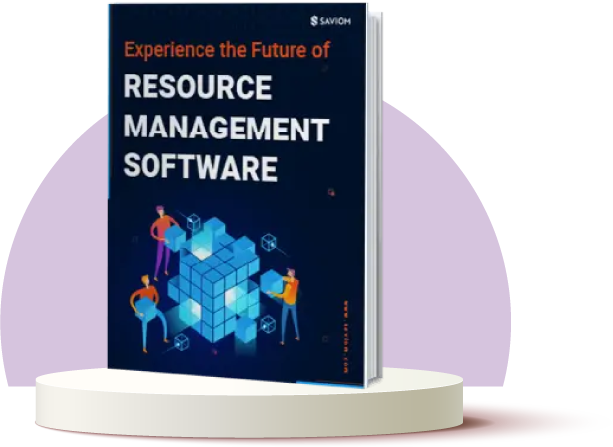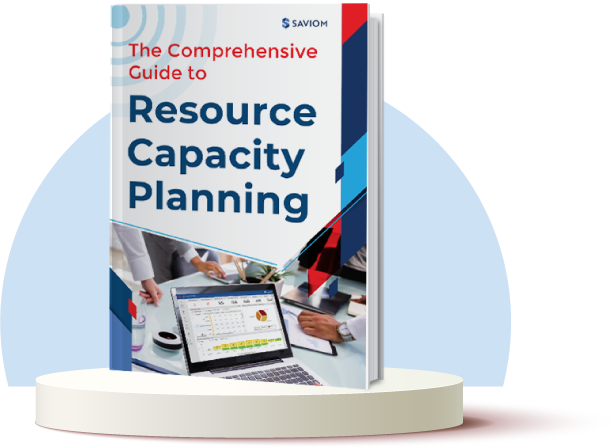Division of labor was the foundation of traditional organizational structures. In such hierarchies, employees had a single reporting line where they would report to only one manager or ‘boss.’ However, as companies started expanding their operational boundaries, multiple functional units emerged. As conventional hierarchical structure could not deal with the growing business complexities due to siloed departments, it gave way to matrix organizations.
Let’s say, a project belonged to Department A and required competencies from Department B, the respective manager would hoard or hide the resources instead of freeing them up to take on the project. Thus, the project suffered from a resource crunch as there was no visibility into enterprise-wide resources due to restrictive boundaries. Moreover, it led to unnecessary hiring of the same competencies, resulting in cost escalations.
Transitioning to a matrix organizational structure can help overcome this significant roadblock and allow seamless inter-departmental workforce distribution for better business efficiency.
It offers a plethora of benefits, starting from proficient information exchange among various departments to enhanced workforce productivity. However, the complex nature of the matrix structure brought forward new challenges for organizations.
This article explains the resource-related challenges that arise in a matrix organization and proven practices to overcome them.
Let’s start by understanding what is a matrix organizational structure.
What is a Matrix Organization?
Based on the Gallup survey, eighty-four percent of the US employees were matrixed to some extent.
A matrix organization is defined as a work structure that has dual or multiple managerial responsibilities and accountability. In other words, it is regarded as the ‘multiple command and control managerial’ concept, where employees report to two or more managers. The matrix management structure has grown in prominence in recent times as it facilitates seamless cross-departmental collaboration and promotes efficient utilization of business resources across organizational boundaries.
Out of the two chains of command, one is along the functional lines, such as department or line managers, and the other is the project, product, or client lines. While employees are accountable to the project or product manager for their work, they report to the functional or line manager for daily operations, leave approvals, and performance evaluations.
Based on the project manager’s authority, a matrix organizational structure is divided into three categories, as listed below.
Types of Matrix Organization Structure
Every organization is unique, and so is its managerial structure. So, when they follow a matrix-based setup, either the project manager or functional manager gets the highest level of authority, or both are at the same level.
Here is an overview of the three types of matrix organizational structures, categorized by the level of authority and influence between project managers and line/functional managers:
Weak Matrix Organization
When the balance of decisive power shifts from the project manager’s direction to the line managers, it forms a weak matrix management. In this structure, the line managers control the project budget, and the project managers act as coordinators or expediters.
Balance Matrix Organization
As the name suggests, a balanced matrix organization provides decisive power to both project and line managers. Both of them will share the authority and have control over the project finances. A balanced matrix organization is an ideal scenario but a rare occurrence in real life.
Strong Matrix Organization
The project manager takes over the reins in a strong matrix organization. It usually happens when the organization procures a critical project, and the upper management deems it necessary for project managers to supervise every aspect of the project to improve performance. Strong matrix organizations prove beneficial in construction projects where project managers are better equipped to make budgeting decisions.
Given the basics of matrix organizations, let’s understand it with an example.
Matrix Management Structure Example
Let’s take the example of a graphic designer in the marketing department of a firm. This designer reports to two managers: a project manager and a line manager. The project manager oversees the designer’s work for a specific marketing campaign, including tasks, milestones, and deadlines.
Meanwhile, the graphic designer reports to their line manager for daily operations, such as BAU, other work allocations, leave approvals, training/upskilling, and performance evaluations.
The line manager must ensure the specific resource is optimally utilized across all project and non-project work. Moreover, they are responsible for the designer’s career growth and development within the department. This dual reporting system allows the designer to balance project-specific duties with ongoing departmental responsibilities.
Read more: What is Matrix Management and Why is it Important?
Now, let’s go through the importance of matrix organization structure.
Benefits of Matrix Organization Structure
One of the primary reasons for adopting and evolving into a matrix organizational form is that it helps break down disparities and collate the whole system.
The following section highlights all the benefits offered by this particular structure:
Complete Transparency and Clarity on Project Objectives
In traditional organizational forms, the exchange of information is only one-directional and function-specific. For example, if you work in the marketing department, you will report to only your department manager. Thus, communication is restricted, and it only flows from the higher-ups to the frontline employees. This lack of interaction between function-specific teams and project managers creates role ambiguity.
However, matrix structures can resolve this issue by bringing interdisciplinary teams on the same page. Additionally, matrix team members have multiple reporting lines, allowing them to coalesce with functional and project managers. This practice ascertains information is freely shared rather than being siloed. As a result, it promotes a transparent and collaborative work culture.
Enhanced Knowledge Sharing Across Verticals
Fostering an open work environment is the cornerstone of developing a matrix-based structure. Suppose you are working in your firm’s marketing department but contributing to a website development project. Your functional manager updates you about the recent trends in graphic design and marketing that can enhance the user experience.
Since the departments do not have boundaries, you can convey this information to your project manager and the team. Together, you can work on developing a website incorporating the latest technology trends and further elevating client satisfaction. This practice can improve the quality of the end product and enhance the knowledge base of your team members coming from different verticals or functional areas.
Maximizes Utilization Levels of Resources
Resources are the most significant investment and success drivers of every organization. However, the growing skills demand and market uncertainties have led to a crippling talent shortage globally. Therefore, managers must ensure that they tap into the maximum potential of their existing workforce and utilize them most intelligently.
The shared services model of matrix organizations allows managers to deliver more projects with fewer resources.
Let’s consider the previous example of a marketing associate (the graphic designer) working on a website development project. It shows that resources do not have to work on projects limited to their department. Instead, they can be distributed to cross-departmental projects. This reduces the need to hire additional employees and improves the productive utilization of current ones.
Read more: What is Resource Utilization? A Complete Guide to Improve Business Efficiency
Higher Employee Engagement and Morale
According to a Gallup poll, employees of a matrixed organization are more engaged than their non-matrixed counterparts.
Employee engagement and enthusiasm for work occur when employees’ interests and growth are addressed appropriately by the employer. In matrix organizations, resources get the opportunity to contribute to a diverse project portfolio. It allows them to utilize their competencies in different ways and credit more skills to their existing job profiles.
At the same time, employees have the liberty to collaborate and exchange knowledge with their cross-departmental colleagues. All this collectively offers them a sense of belonging, and they feel more driven to contribute to organizational success.
Access to Diverse Skills and Perspectives
Matrixed structure promotes employees to go beyond their functional boundaries and explore multi-faceted projects. For example, let’s say a marketing associate has content writing as their secondary skill set, and a project requires ten content writers. So, if there is a resource crunch, resource managers can initiate a training/upskilling program to hone the associate’s writing skills.
This approach allows resources to diversify their skill sets. Furthermore, when cross-disciplinary employees come together to work on a project, they bring multiple perspectives and ideas to the table. It enables quick problem-solving as different mindsets have varied approaches to resolving the same issue.
Leverage Cost-effective Global Resources Across Matrix Boundaries
One of the most critical project constraints for stakeholders is managing the project budget, which directly affects business profitability. Therefore, it’s imperative for managers to create the right project resource mix to prevent budget overruns. However, this task is arduous in traditional hierarchical structures due to siloed departments.
Matrix organizations, on the other hand, eliminate geographical and departmental boundaries. As a result, resource managers have complete visibility of employees based at different locations, their skills, charge out rate, etc. Thus, they can schedule a resource with the same expertise from a low-cost site to maintain the project’s financial health. It helps them reduce the project costs while ensuring its quality.
Read more: Top Ten Business Benefits of Resource Management
Resourcing Challenges in a Matrix Organization
Since matrix organizations are complex and have multiple reporting lines, issues like lack of clarity in managerial roles and responsibilities can surface. As a result, it can disrupt the overall functioning and cause internal conflicts.
Here is a curated list of some of the downsides:
Managerial Conflicts Competing for the Same Resources
A shared services model can benefit the firm but also lead to a chaotic, less conducive environment. For example, consider a scenario where two projects demand the same critical resource. Naturally, the project managers will prioritize their own needs and request the resource manager to allocate this specific resource to their own projects.
As a result, a conflicting situation can develop between functional and project managers. Such discrepancies can create ambiguity when deciding which direction the managerial power should shift. Thus, it creates an imbalance and destroys the whole meaning of matrix structures.
The Unclear Demarcation Between Employee’s Functional and Project Roles
Gallup’s research suggests that, though matrixed employees are more engaged than non-matrixed ones, they’re less clear about expectations at work.
This lack of clarity stems from dual or multiple authority. For example, employees are often uncertain about who is their immediate reporting manager. Moreover, an imbalance in power can blur the lines of priority work. In simple terms, the resources will not know if they should prioritize their project or functional work.
Adding to this ordeal are challenges such as communication gaps and role ambiguity that permeate the system. When multiple leaders and managers often regulate a large interdepartmental team, they fail to communicate the goals and expectations. As a result, it puts the resources in an awkward spot as they can’t gauge the impact of their work in the bigger picture.
Confusions in Project Priorities and Resource Allocations
In a matrix organization, resource managers receive multiple resource requests, and more often than not, these projects demand a similarly skilled workforce. Thus, the ‘first come, first serve’ basis of fulfilling these demands becomes obsolete.
As simple as it sounds, every project and functional manager deems their work high-priority, making the resource manager’s job more difficult. The conflicting precedence leads to confusion and slows down the decision-making power of resource managers as they fail to decide which project should be assigned first.
Read more: What is Resource Allocation? A Comprehensive Guide for Project Success
Difficulty in Controlling & Monitoring Resource Metrics
In a conventional work structure, it is relatively simple to check your resources’ utilizations, work rates, allocations, etc. That’s because there is only one reporting manager, and they have only one function, which is to supervise and regulate.
However, the layers in a matrix organization bring forward a new obstacle for both resource and project managers. Since the employees are dispersed across the enterprise and work on multiple projects, managers find controlling and monitoring the resource metrics arduous. It’s also because communicating with every employee about their work status becomes tedious.
Frequently Overloading Resources Cause Employee Burnout
From an employee’s perspective, being a part of a layered structure can be challenging. They are committed to multiple projects and have to do justice to each. Moreover, they have to maintain harmony with different teams and several managers, which requires significant adjustments. All this can create unnecessary distress among them.
Moreover, resource managers divide the critical resources’ schedule between several projects to balance the conflicting priorities. This can overload the employee, increase their work stress, and eventually lead to burnout. The pressure caused by constantly shifting dynamics and mental fatigue can also result in prolonged absences and unplanned attrition.
Read more: Why is the Overallocation of Resources Bad for You?
Ambiguity in Reviewing Employee Performance
Performance review and appraisal systems at old-school work structures are more direct as one functional manager provides feedback about the employees’ overall performance. However, as the organizations diversified and evolved into matrixed forms, the whole process became more time-consuming and complex.
For instance, if the people manager has to conduct the annual performance appraisal, they have to start collating reviews from different project managers for a specific employee. However, there is no guarantee that the feedback will be uniform. That’s because some managers can provide a biased review due to internal discrepancies, favoritism, etc. All these factors can create a major roadblock in reviewing the employees’ performance.
Read more: What is Employee Performance Management, and Why is it Important?
The solution to combat all the challenges mentioned above lies in implementing the right resource management software. Let’s learn about it in the following section.
How Can an ERM Solution Help Overcome These Challenges in Matrix Organizations?
Among the many tools and software available, a resource management solution enables firms to utilize their talent most intelligently across matrix boundaries and enhance project outcomes.
The advanced features allow you to:
Ascertain Competent Resource Allocation with Unmatched Visibility
The tool provides unmatched visibility of enterprise-wide resources and their attributes like- skills, locations, competencies, capacity, cost rate, etc., and maintains a single version of the truth. This enables resource managers to identify competent resources and allocate them to suitable projects for a definite timeline, thus ensuring successful project execution and delivery.
Minimize budget Overrun by Allocating Low-cost Global Resources
In this case, let’s say an employee is based out of a low-cost location like- India, and the resource manager is planning a USA project with a similar demand. With the tool’s unified view and advanced filters, the resource manager can simply book this employee for the USA project. This way, managers can leverage cost-effective global resources across matrix boundaries and minimize project expenses.
Foresee and Optimize Utilization to Prevent Burnout
As mentioned earlier, the complexities of matrix organization can cause employee burnout. To mitigate this, managers can gain insight into resource utilization levels with the help of the tool’s real-time reports and optimize the resource schedule before it goes beyond the threshold. They can also use resource leveling or smoothing techniques to optimize the utilization level.
Avoid Internal Conflicts with Automated Resource Requisition
The automated resource requisition system, paired with standard prioritization practices, can minimize power conflicts between different managers. In addition, it maintains an audit trail that keeps everyone, including the stakeholders, in the loop, thereby promoting transparency.
Enable Quick Decision-Making with Data-driven Insights
The business intelligence feature of the tool offers real-time insights into all the necessary metrics, such as resource availability, utilization, capacity vs. demand, people on the bench, etc. Managers can leverage this data and make quick data-driven decisions to create an optimized talent pool.
Read more: How Can You Make Data-Driven Decisions with Resource Management Software?
Enhance Communication with Collaboration Tool
The collaboration feature of the tool helps streamline communication among team members by providing a centralized platform for discussions, file sharing, and real-time updates. This ensures that everyone is on the same page, reduces misunderstandings, and enhances productivity.
Prioritize Projects with What-If Analysis Feature
The tool’s what-if analysis feature helps prioritize projects by allowing managers to simulate different scenarios and their outcomes. By adjusting variables such as resource allocation, timelines, and budget constraints, managers can make informed decisions and ensure that the most critical projects receive the necessary resources and attention.
Read more: Top Ten Resource Management Best Practices for Business Efficiency
Tips for Effective Matrix Management
Here are some additional tips that can help you create and maintain an effective matrix management structure:
- Share equal authoritative power between project and line managers to form a balanced structure or allow the upper management to decide who will play a more directive role based on different scenarios. It helps minimize discrepancies.
- Maintain a dialogue with the resources to convey the goals and expectations with utmost clarity and negate role ambiguity.
- Create an effective escalation matrix for conflict resolution.
- Implement a modern resource management tool to resolve complexities and efficiently manage resources across matrix boundaries.
- Standardize project prioritization to eliminate confusion in resource allocations.
- Encourage multi-skilling to increase overall productive utilization.
- Replace the traditional appraisal system with a comprehensive approach involving 360-degree feedback, continuous improvement, learning, etc.
- Organize training and form individual development programs to prepare the workforce to take on multi-faceted projects.
- Formulate work policies to ensure the smooth functioning of the system with no power conflicts.
- Implement a rotational policy within the organization. Resources must be out-rotated and given a new opportunity if they spend more than a certain period in a specific role.
The Glossary
Read more: Glossary of Resource Workforce Planning, Scheduling and Management
The SAVIOM Solution
SAVIOM is the market leader in providing an Enterprise Project Resource Management solution. With over 20 years of experience leading the market, Saviom is actively used by over 15 highly esteemed global companies worldwide. The tools within the suite include project portfolio management, professional service automation, and workforce planning software. It also entails supporting solutions to schedule equipment and assets seamlessly. Re-engineer your project management efficiency with a system shaped around your business!











